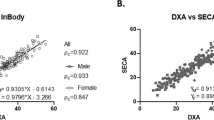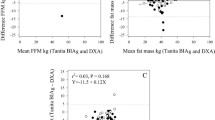Abstract
The aim of this study was to investigate the accuracy of BIA in the measurement of total body composition and regional fat and the fat free mass in the healthy young adults. Four hundred and three healthy young adults (167 women and 236 men) aged 18–29 years were recruited from the Mid-West region of Ireland. Multi frequency, eight-polar bioelectrical impedance analysis (BIA) and dual energy X-ray absorptiometry (DXA) were used to measure the total body and segmental (arm, leg and trunk) fat mass and the fat free mass. BIA was found to underestimate the percentage total body fat in men and women (p < 0.001). This underestimate increased in men with >24.6% body fat and women with >32% body fat (p < 0.001). Fat tissue mass in the trunk segment was overestimated by 2.1 kg (p < 0.001) in men and underestimated by 0.4 kg (p < 0.001) in women. BIA was also found to underestimate the fat free mass in the appendages by 1.0 kg (p < 0.001) in men and 0.9 kg (p < 0.001) in women. Compared to dual energy X-ray absorptiometry, bioelectrical impedance analysis underestimates the total body fat mass and overestimates fat free mass in healthy young adults. BIA should, therefore, be used with caution in the measurement of total body composition in women and men with >25% total body fat. Though statistically significant, the small difference (~ 4%) between the methods indicates that the BIA may be used interchangeably with DXA in the measurement of appendicular fat free mass in healthy young adults.






Similar content being viewed by others
References
Baumgartner RN (1996) Electrical impedance and total body electrical conductivity. In: Roche AF, Heymsfield S, Lohman TG (eds) Human body composition. Human Kinetics, Champaign, IL, pp 79–107
Bland JM, Altman DG (1986) Statistical methods for assessing agreement between two methods of clinical measurement. Lancet 1:307–310
Bowden RG, Lanning BA, Doyle EI, Johnston HM, Nassar EI, Slonaker B, Scanes G, Rasmussen C (2005) Comparison of body composition measures to dual-energy X-ray absorptiometry. J Exerc Physiol online 8(2):1–9
Deurenberg P, Weststrate JA, Paymans I, van der Kooy K (1988) Factors affecting bioelectrical impedance measurements in humans. Eur J Clin Nutr 42(12):1017–1022
Deurenberg P, Andreoli A, Borg P, Kukkonen-Harjula K, de Lorenzo A, van Marken Lichtenbelt WD, Testolin G, Vigano R, Vollaard N (2001) The validity of predicted body fat percentage from body mass index and from impedance in samples of five European populations. Eur J Clin Nutr 55(11):973–979
Duz S, Kocak M, Korkusuz F (2009) Evaluation of body composition using three different methods compared to dual-energy X-ray absorptiometry. Eur J Sport Sci 9(3):181–190
Ellis KJ (2000) Human body composition: in vivo methods. Physiol Rev 80(2):649–680
Furstenberg A, Davenport A (2011) Comparison of multifrequency bioelectrical impedance analysis and dual-energy X-ray absorptiometry assessments in outpatient hemodialysis Patients. Am J Kidney Dis 57(1):123–129
Gallagher MR, Walker KZ, O’Dea K (1998) The influence of a breakfast meal on the assessment of body composition using bioelectrical impedence. Eur J Clin Nutr 52:94–97
Gallagher D, Heymsfield SB, Heo M, Jebb SA, Murgatroyd PR, Sakamoto Y (2000) Healthy percentage body fat ranges: an approach for developing guidelines based on body mass index. Am J Clin Nutr 72:694–701
Genton L, Hans D, Kyle UG, Pichard C (2002) Dual-energy X-ray absorptiometry and body composition: differences between devices and comparison with reference methods. Nutrition 18(1):66–70
Glickman SG, Marn CS, Supiano MA, Dengel DR (2004) Validity and reliability of dual-energy X-ray absorptiometry for the assessment of abdominal adiposity. J Appl Physiol 97:509–514
Huizenga R, Barden HS, Oates MK (2007) Precision of Lunar iDXA total body BMD and composition measurements on obese subjects. Paper presented at the ISCD Annual Meeting. Tampa, FL, USA
Hull H, He Q, Thornton J, Javed F, Wang J, Pierson RN Jr, Gallagher D (2009) iDXA, Prodigy, and DPXL dual-energy X-ray absorptiometry whole-body scans: a cross calibration study. J Clin Densitom 12(1):95–102
Kriemler S, Puder J, Zahner L, Roth R, Braun-Fahrlander C, Bedogni G (2009) Cross-validation of bioelectrical inpedance analysis for the assessment of body composition in a representative sample of 6- to 13-year-old children. Eur J Clin Nutr 63:619–626
Kyle UG, Bosaeus I, De Lorenzo AD, Deurenberg P, Elia M, Gomez JM, Heitmann BL, Kent-Smith L, Melchoir JC, Pirlich M, Scharfetter H, Schols AMWJ, Pichard C (2004) Bioelectrical impedance analysis-part 1: review of principles and methods. Clin Nutr 23:1226–1243
Malavolti M, Mussi C, Poli M, Fantuzzi A, Salvioli G, Battistini N, Bedogni G (2003) Cross-calibration of eight-polar bioelectrical impedance analysis versus dual-energy X-ray absorptiometry for the assessment of total and appendicular body composition in healthy subjects aged 21–82 years. Ann Hum Biol 30(4):380–391
Oates MK, Barden HS, Huizenga R (2007) Body composition with idxa in obese subjects with and without metabolic syndrome. Paper presented at the ISCD Annual Meeting. Tampa, FL
Oshima Y, Shiga T (2006) Within-day variability of whole-body and segmental bioelectrical impedence in a standing position. Eur J Clin Nutr 60:938–941
Pietrobelli A, Rubiano F, St-Onge M-P, Heymsfield SB (2004) New bioimpedance analysis system: improved phenotyping with whole body analysis. Eur J Clin Nutr 58:1479–1484
Roubenoff R, Kehayias JJ, Dawson-Hughes B, Heymsfield SB (1993) Use of dual-energy X-ray absorptiometry in body-composition studies: not yet a “gold standard”. Am J Clin Nutr 58:589–591
Rubiano F, Nunez C, Heymsfield SB (2000) A comparison of body composition techniques. Ann NY Acad Sci 904:335–338
Sun G, French CR, Martin GR, Younghusband B, Green RC, Xie Y, Mathews M, Barron JR, Fitzpatrick DG, Gulliver W, Zhang H (2005) Comparison of multifrequency bioelectrical impedance analysis with dual-energy X-ray absorptiometry for assessment of percentage body fat in a large, healthy population. Am J Clin Nutr 81:74–78
Tataranni PA, Ravussin E (1995) Use of dual-energy X-ray absorptiometry in obese individuals. Am J Clin Nutr 62(4):730–734
Wattanapenpaiboon N, Lukito W, Strauss BJG, Hsu-Hage BHH, Wahlqvist ML, Stroud DB (1998) Agreement of skinfold measurement and bioelectrical impedance analysis (BIA) methods with dual energy X-ray absorptiometry (DEXA) in estimating total body fat in Anglo-Celtic Australians. Int J Obes 22:854–860
Acknowledgments
This study was supported by funding from a University of Limerick Research Grant.
Conflict of interest
The authors declare no conflict of interest.
Author information
Authors and Affiliations
Corresponding author
Additional information
Communicated by Susan A. Ward.
Rights and permissions
About this article
Cite this article
Leahy, S., O’Neill, C., Sohun, R. et al. A comparison of dual energy X-ray absorptiometry and bioelectrical impedance analysis to measure total and segmental body composition in healthy young adults. Eur J Appl Physiol 112, 589–595 (2012). https://doi.org/10.1007/s00421-011-2010-4
Received:
Accepted:
Published:
Issue Date:
DOI: https://doi.org/10.1007/s00421-011-2010-4




